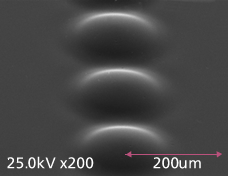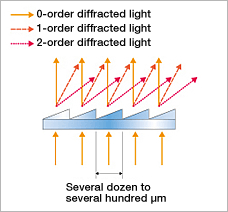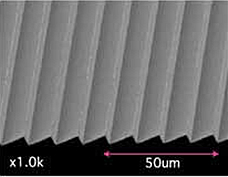Precision Micro Optical Elements

MLA (microlens array)

DOE (diffractive optical element)

Surface of DOE
The term "precision micro optical element" refers to a wide range of tiny lenses, prisms, filters and other optical components, each about the size of a grain of rice.
There is more involved than merely making conventional lenses smaller, though; a variety of microfabrication techniques are used to give them their unique characteristics.
One of these components is the microlens array, or MLA.
An array of tiny lenses (usually convex), only several dozen to several hundred μm*1 in diameter, are formed on the surface of an optical element to create an MLA. Applications for these elements as key components in optical fiber systems for parallel processing of optical signals are growing rapidly.
Nikon fabricates each of these individual microlenses precisely to an aspherical shape.
Another important precision optical element is the DOE (diffractive optical element).
Standard lenses change the direction of light through refraction, but DOE changes the light path through diffraction.
Today, blazed gratings*2, a type of DOE, are attracting considerable interest for a special characteristic: they concentrate all incident light toward a specific direction (a specific diffractive order).
The surfaces of micro blazed gratings manufactured by Nikon have extremely small lines, with a sawtooth-shaped cross-section, ruled on them. The rules are only between several dozen and several hundred micrometers crosswise, which demands extremely fine microfabrication technology.
These devices are expected to play a vital role in the continuing development of information and communications, especially in the fast-growing realm of optical fiber communications.
- *1One millionth of a meter.
- *2A special type of diffraction grating, where the grooves are triangular to boost the diffraction efficiency of particular orders of light.
Renewed April 2007
